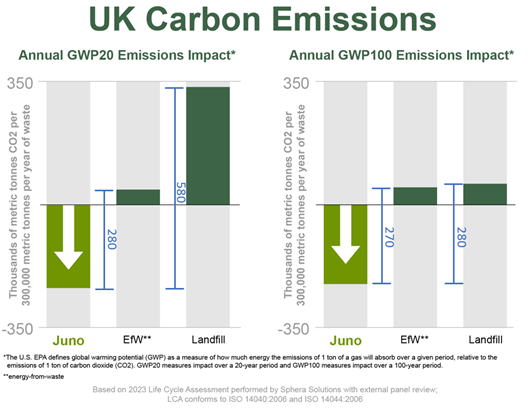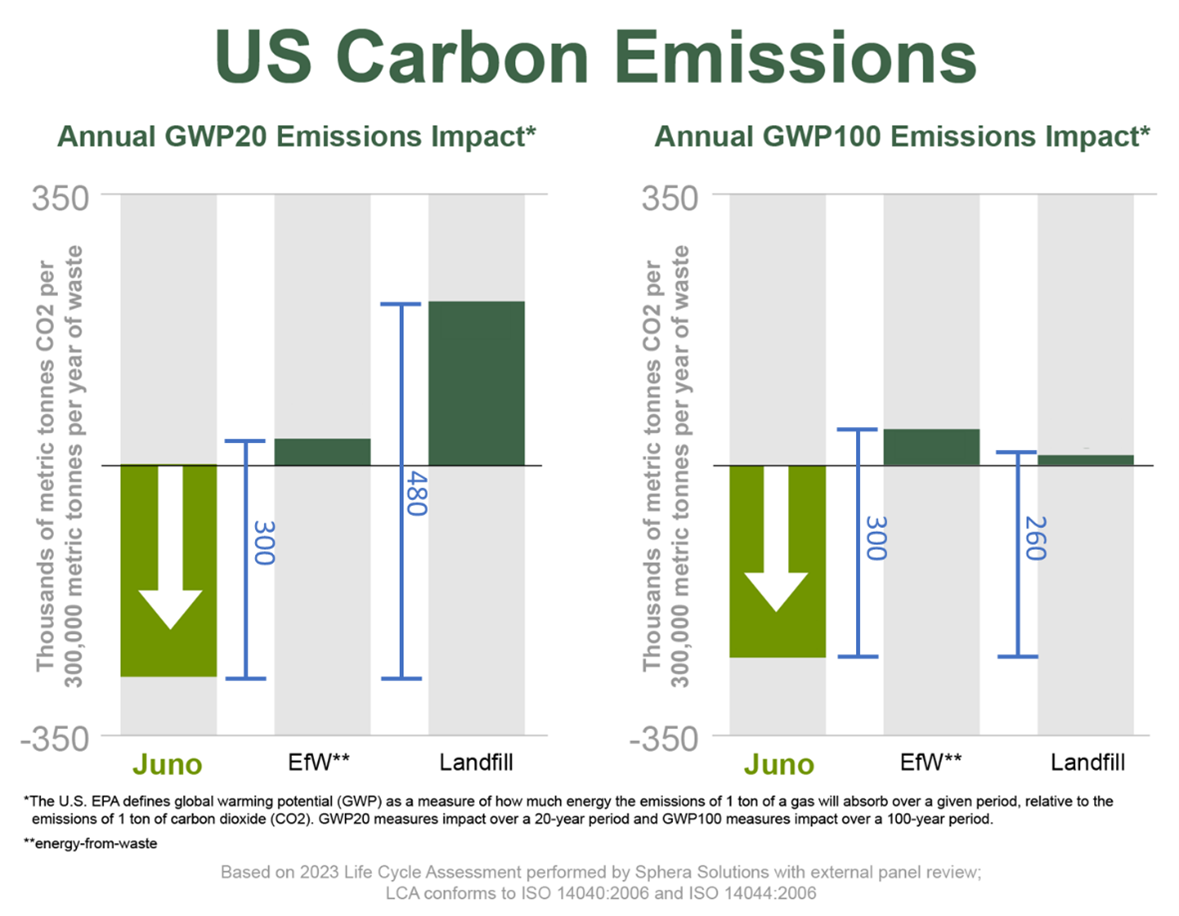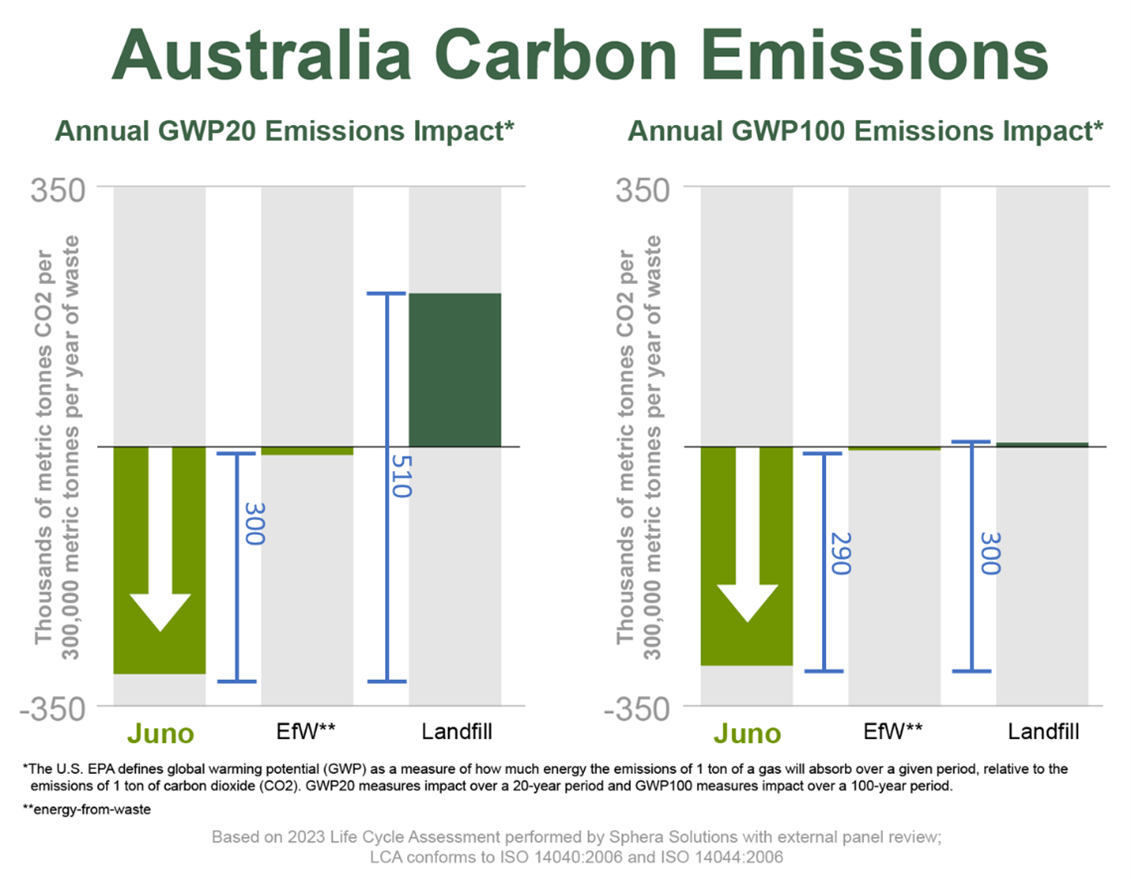Juno® Technology Offers UK Significant Reduction in Carbon Emissions
)
Facility could reduce GWP20 by about 580,000 metric tonnes/year of CO2e compared to landfill
ATLANTA – Sept. 12, 2023 – Juno, an award-winning waste recovery technology pioneered by Georgia-Pacific, today shared data from a third party critically reviewed life cycle assessment (LCA)* which demonstrates its solution can make a measurable impact in helping municipalities reach their climate goals.
The assessment was conducted by Sphera Solutions**, a provider of Environmental, Social and Governance (ESG) consulting services. It measures Juno’s potential impact compared to municipal solid waste landfills and energy-from-waste (EfW) disposal methods in the United Kingdom, United States and Australia using ISO 14044:2006 standards.
“When you recycle commodities rather than incinerating or landfilling, you reduce carbon emissions,” said Christer Henriksson, Juno’s president. “Assessing Juno’s impact with a respected third party is important as we aim to assist municipalities across the globe in managing waste effectively and reducing carbon emissions. Every day more landfills are reaching capacity, and we need to act now.”
Through a patented wet waste processing solution designed to separate and sanitize waste that is generated in households and businesses, Juno captures previously unrecoverable paper fibers in the waste stream such as from cups with plastic coatings or paper-based packaging with food contamination. In addition to recapturing paper fiber, other recyclable materials like metals and plastics are reclaimed for new, beneficial uses, while food can be converted into renewable biogas.
The findings of the LCA reveal:
In the U.K., using a GWP20*** model, every year that a Juno facility processes its annual capacity of 300,000 metric tonnes of waste instead of that waste being disposed in a landfill, it would reduce GWP20 by approximately 580,000 metric tonnes of CO2e (carbon dioxide equivalent). According to the Environmental Protection Agency’s (EPA) Greenhouse Gas Equivalencies Calculator, this is equivalent to greenhouse gas emissions avoided by 28,000 garbage trucks of waste or about 25 million trash bags of waste diverted for recycling instead of landfilled. GWP20 would be reduced by about 280,000 metric tonnes of CO2e if the material sent to Juno would have been otherwise combusted in an EfW facility.
“An LCA provides a foundation for making quantitative comparisons between alternatives,” said James Levis, principal consultant, Sphera Solutions. “This study was critically reviewed by an international panel of three independent experts, who confirmed that it conformed to the relevant international standards. Therefore, this study provides a strong foundation for comparing the potential environmental impacts from each of the studied alternatives.”
In the United Kingdom, using a GWP100*** model, every year that a Juno facility processes its annual capacity of 300,000 metric tonnes of waste instead of that waste being disposed in a landfill, it would reduce GWP100 by approximately 280,000 metric tonnes of CO2e (carbon dioxide equivalent). According to the Environmental Protection Agency’s (EPA) Greenhouse Gas Equivalencies Calculator, this is equivalent to greenhouse gas emissions avoided by about 13,000 garbage trucks of waste or about 12.2 million trash bags of waste diverted for recycling instead of landfilled. GWP100 would be reduced by about 270,000 metric tonnes of CO2e if the material sent to Juno would have been otherwise combusted in an EfW facility.
Corresponding impacts in the U.S. and Australia are illustrated in the graphs below.****
“The primary sources of methane emissions are agriculture, natural gas systems, and landfills,” said Nagapooja Seeba, Juno’s director of environmental sustainability. “Methane breaks down to CO2 in approximately 12 years on average, so while methane is 29.8 times more potent than CO2 over 100 years, it is 82.5 times more potent over 20 years. That’s the reason Juno is effective at reducing carbon emissions relative to landfills over 100 years but is even more effective over this shorter timeframe.”
The first Juno commercial unit began processing local solid waste in Toledo, Oregon (U.S.) in May of 2021, with an annual capacity of 60,000 to 70,000 tons. In its first year of operation, Juno Oregon nearly tripled landfill diversion rates in Toledo. Future, more expansive Juno systems will be capable of processing 300,000 metric tonnes of waste per year using additional sorting equipment. Future facilities will be able to capture biogas, driving potential diversion rates to 90 percent of waste processed.
In March through May 2023, Juno partnered with King County (WA, U.S.) to conduct a mixed waste processing trial, which processed 737 tons of waste – equivalent to about 29,000 trash bags – and diverted an average of 46% of materials from Cedar Hills Regional Landfill that is projected to reach capacity by 2031. If all of King County’s waste was processed through future Juno systems, the municipality could capture the 70% – over 450,000 tons per year – of recyclable materials currently landfilled that it has identified as part of its Re+ zero waste initiative. That’s about 17.6 million trash bags diverted from the landfill a year.
For more than a decade, Georgia-Pacific researched better ways to recover more paper fiber from waste streams and help increase paper recycling. The company developed and patented Juno Technology as an environmentally and economically responsible solution to increase recycling and recovery. Juno aims to build two additional plants in the U.K. within the next five years, with additional plans to develop more facilities in the U.S. and expand to Australia.
*According to Sphera Solutions , a Life Cycle Assessment (LCA) is defined as the systematic analysis of the potential environmental impacts of products or services during their entire life cycle.
**Based on 2023 Life Cycle Assessment performed by Sphera Solutions with external panel review; LCA conforms to ISO 14044:2006.
***The U.S. EPA defines global warming potential (GWP) as a measure of how much energy the emissions of 1 ton of a gas will absorb over a given period, relative to the emissions of 1 ton of carbon dioxide (CO2). GWP20 measures impact over a 20-year period and GWP100 measures impact over a 100-year period.
****GWP20 and GWP100 impacts across U.K., U.S., Australia. Note negative results detailed below are due to credits for the substitution of recovered materials and energy for virgin materials and grid electricity, respectively.





